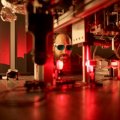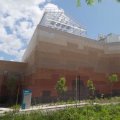University of Queensland researchers have received Korean backing to develop an ingenious new system of small antennas.
The antennas act as building blocks in radar systems, terrestrial communication systems and for direct broadcast satellite TV.
The researchers in the University's Wireless Communications Group say the prototype wireless communications system could be used instead of, or to augment the controversial overhead cabling of metropolitan Australia and so minimise cabling.
They also say that the system could be used to provide economically feasible access to satellite TV for small rural towns for which other cabling systems would prove uneconomic.
The project has attracted $12,000 funding from Korean university, the Pohang University of Science and Technology (known as Postech) and has caught the attention of Australian defence authorities interested in high frequency array antennas for Synthetic Aperture Radar.
It is also being funded as part of a $132,000 Australian Research Council grant announced to project leader Associate Professor Marek Bialkowski in the 1997 round.
Dr Bialkowski said the developed antennas could be used in the so-called 'last mile' connection systems.
'These systems are under development in the USA and their purpose is to avoid expensive cabling systems between individual households and a communications exchange in an area of approximately one mile radius,' he said.
'Small antennas and associated systems can be installed close to the window to obtain one-way or interactive services with the base station.'
The standard microstrip patch antennas had been known for some years, but did not offer enough operational bandwidth, he said.
'To increase operational bandwidth, we explored a multi-layer antenna design approach with standard thin dielectric substrates and inexpensive dielectric foam material.'
Dr Bialkowski collaborated with a member of the Wireless Communications Group in the Electrical and Computer Engineering Department, masters in electrical engineering student Hyok-Jae Song. They reduced the design cycle time and developed a more sophisticated system of antennas with enhanced bandwidth using CAD software packages in the design process. The new design and development strategies they proposed are described in an article which within a single week was accepted for publication in the Microwave Journal.
The microstrip patch antenna arrays - each the size and less than the thickness of a small wall tile - need to use a clever computer-aided design to make them highly efficient.
Dr Bialkowski visited Korea in 1995 to establish research links. He said Mr Song visited Postech in December to deliver two antenna prototypes and to demonstrate how to build a single element and an array in the system. He received an enthusiastic reception. Postech was pleased with the outcome and would include the research in its yearly report.
'The current debate in Australia revolves around the overhead cabling of metropolitan Australia by Optus and Telstra,' Dr Bialkowski said.
'By using safe millimetre wave frequencies, excellent results can be achieved instead using a wireless system.
'The use of the millimetre frequencies restricts the application to strictly line of sight.
'The major advantage of these frequencies is that it is possible to employ high re-use densities of the available bandwidth frequencies safely.
'Available research data for these systems confirms the suitability of the system for high bandwidth applications.
'The other advantage of these systems is that they can be rolled out into regional semi-rural and rural areas economically quicker than cabled-based applications.
'A town like Cunnamulla could be covered with three transmitters, and individual antennas at each household pointing to them.
'The cost of each antenna is about $10, plus terminal equipment bringing up a total household cost of about $500, which is about half the cost of current commercial alternatives. They are very simple for an average person to install without prior electronic knowledge.'
Dr Bialkowski said each antenna within the system had a unique address, which it retained even if the home owner moved the antenna to another suburb.
'Last mile technology is portable and adaptable making it suitable for urban and high density application,' he said.
For further information, contact Dr Bialkowski, (telephone 3365 3563, email meb@elec.uq.edu.au) or laboratory manager Ray Whitehead (telephone 3365 3569, email rjw@elec.uq.edu.au).



